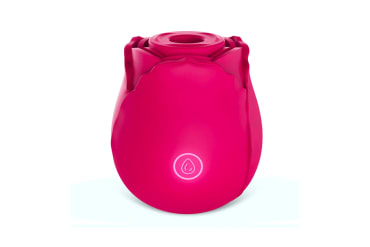
Our editors have independently chosen the products listed on this page. If you purchase something mentioned in this article, we may earn a small commission.
December 6, 2021 — 11:13 AM
In the past, astrology, tarot, and medium readings have been relegated to dark, moody shops—off the beaten path and not the most accessible. But as more people, particularly young people, look beyond organized religion for answers to life’s biggest questions, these previously esoteric approaches are gaining mass appeal.
Wherever you look for it, there’s undeniable value in finding faith in the unseen. According to a 2014 study out of Columbia University, living a spiritual life can help protect you against depression. In fact, maintaining what lead researcher Lisa Miller, Ph.D., calls an “awakened awareness” can actually change the brain, helping us respond to setbacks, trust in our paths, and feel supported through life’s ups and downs.
That’s why we’re cautiously optimistic to watch how technology is now spreading spiritual well-being further and wider than ever before. We expect to see this pandemic-born trend continue to endure—but hope that it never makes us lose sight of the value of offline spiritual practice.
How spirituality went viral.
These days, it feels like in order to tap a higher power, all you need to do is tap your phone screen.
calm+
Next-generation stress relief, featuring EU organic hemp oil, ashwagandha, and lavender oil*

We first noticed spirituality start to slip into the digital space in a new way in 2018. Meditation apps were hot investments, and platforms like Co-Star, which pinged users’ phones with daily astro readings and zodiac-inspired tips, hinted at exciting things to come. Of the inspiration to turn astrology into an app, Co-Star founder Banu Guler told mindbodygreen, “When people are getting their iPhones fixed, they almost look like broken humans. Technology is touching every aspect of our lives; it’s only a matter of time before everything becomes a sort of technological version of itself.”
The pandemic proved her right. When our entire lives were relegated to screens in 2020, digital spiritual practices gave people space to find meaning during an otherwise hollow time. And nowhere were they more in-demand than on TikTok.
Sarah Regan, mbg’s spirituality & relationships writer, remembers watching TikTok transform from fringe app to social media platform of choice once the pandemic hit. “Maybe it was something about being away from society in the way that we were used to that made people more willing to put themselves out there online,” she recalls.
One of TikTok’s over 1 billion active users, Melanie of @MysticTarot remembers starting her account around this time, in May of 2020: “The first two videos I posted both went really viral and had over 50,000 likes. I gained followers really quickly,” she tells mbg. Though she was new to the practice and had only bought her first deck only a few months prior, this early success encouraged her to continue posting daily tarot pulls that spoke to the energy of the collective in one minute or less. Her account now has over 229k followers, 10.7 million likes, and is her primary source of income. (Followers can also buy personal readings with her starting at around $5.)
Max Gomez, the co-founder and CEO at Breathwrk, a guided breathing platform, has also found success on the app, amassing over 1 billion views. He has a few guesses on why practices like breathwork translate to social media so seamlessly: “One being that breathing exercises work extremely fast on the mind and body, so their effects can be felt within the time frame of a TikTok,” he tells mindbodygreen. “Another is that oftentimes people feel stress from consuming too much social media; when our exercises pop up on the ‘for you’ page, people take the time to pause and practice with us.”
The quick, informal nature of the app means that creators like Melanie and Max can post videos multiple times a day, whenever inspiration strikes. Videos tagged #Spiritualtok now have 956 million views, and #spiritualmeaning 7.9 billion.
But among these millions upon millions of videos, the deeper meaning behind some of these practices can easily get lost.
What translates to social media, and what gets lost?
Shauna Cummins is a professional hypnotist who started building her practice 10 years ago, connecting with clients through collaborations and in-person events. Though she was an early Instagram adopter—she jokes that she was the first person to use the hashtag #hypnosis on the app—social media has never been her main gig. Flash-forward 10 years and Cummins is the author of Wishcraft: A Guide to Manifesting a Positive Future and the founder of The Divine Feminine School of Hypnosis. She notes that the younger students who have come through her school are starting their careers in a very different—and decidedly more digital—way than she did. “When I see my students doing TikTok, I think it’s great because it’s a big megaphone for portraying what hypnosis is in a cool, connected, fun way,” she says, “but I never want it to be misunderstood as the real work.”
Cummins is one of many experts of the opinion that spiritual exploration, by definition, must happen offline. It’s by sitting in meditation, walking in nature, or working with a practitioner that we access a deeper sense of ourselves and our higher purpose. “There’s no shortcut to it,” Cummins says. These private spiritual moments aren’t always made to be shared. Skipping them in favor of viral highlight reels misses the mark and can ultimately be harmful.
Aurora Luna of @babyreckless is an astrologer and diviner who is active on a number of social media platforms. They note that TikTok is one of the more fun platforms because of its bite-size videos—but it’s not the best for sharing spiritual practices that have a rich cultural history. “It can be a great introduction but a lot of the stuff that is covered on TikTok is not for quick consumption,” they say. “If that source of information gets lost, it just becomes this watered-down concept… You’ve stripped it of its cultural significance.”
Never in history have we had access to so many ideas from all around the world. Tech makes it easier than ever to find spiritual practices that pique our interest and seek new information every day. Luna notes that “this hunger for knowledge is noble, but that knowledge has to be freely given.” When people take practices from other cultures without permission or credit, issues like cultural appropriation can come into play.
We can combat them by using TikTok as inspiration to actually put down our phones and pick up a book, take a class, or connect with an instructor who lives and breathes these practices. After all, Luna adds, “If you feel drawn to something, why would you want to take a shortcut?” Exploring the roots that the practice has in your culture can also be valuable and personally illuminating.
As users continue to call out instances of appropriation and misinformation on social media, we predict (and hope!) that this more active way of engaging with spirituality will become the norm.
The future of spiritual self-care—online and off.
Whether it’s through organized religion, practices like tarot and astrology, or a mix of all the above, exploring something greater than yourself is mentally, physically, and emotionally enriching. Perhaps it’s no coincidence that spirituality went so mainstream on an app whose primary users are 10- to 19-year-olds, during a global pandemic that hit the mental health of children and adolescents the hardest.
There’s undeniable value in platforms that dish up practices that can help us combat loneliness, unease, and lack of purpose with the scroll of the thumb. But moving forward, these apps need to serve as starting points and not final destinations.
This is just one of the trends mbg is predicting for 2022. Check out our full list of the latest health & wellness trends.

calm+
Next-generation stress relief, featuring EU organic hemp oil, ashwagandha, and lavender oil*
calm+
Next-generation stress relief, featuring EU organic hemp oil, ashwagandha, and lavender oil*









